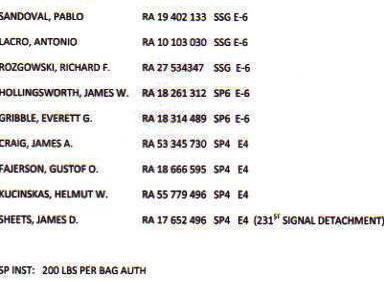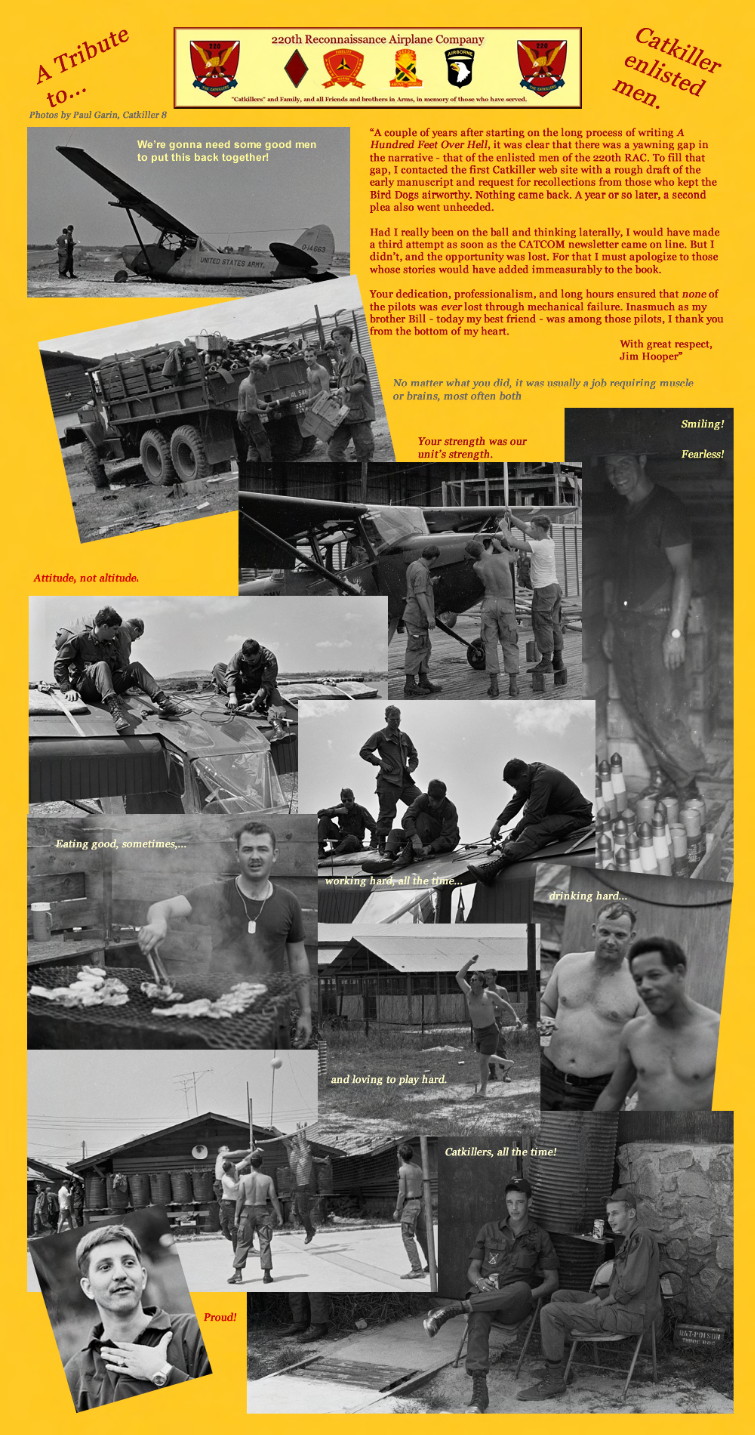220th Enlisted Member Recognition—1965–1971:
The Advance Party in June 1965 included the following Enlisted Men:

| Early July | Gustaf Fajerson (deceased) was instrumental in the design of the 220th unit patch See Additive Notes. |
| 3 Sep 1965 | Specialist Gustaf Fajerson was selected as 14th Aviation Battalion Soldier of the Month (assume this was for August). |
| Dec 1965 | Specialist 5 Ward was awarded Crew Chief of the Month, Aircraft 57-2956, 2nd Platoon, Hue. |
| 10 Dec 1965 | Specialist 4 Kenneth Selby was awarded Army Commendation Medal for locating a badly wounded ARVN soldier during the search for survivors of Operation Harvest Moon |
| Jan1966 | Specialist 5 Harry I. Kee was awarded Crew Chief of the Month, Aircraft 57-2953, 3rd Platoon, Marble Mountain, Da Nang. |
| Feb 1966 | Specialist 4 Hubbard was awarded Crew Chief of the Month, Aircraft 57–2939, 2nd Platoon, Hue. |
| 17 Feb 1966 | Specialist George Castleberry was recommended for the Soldiers Medal for his unsuccessful attempt to rescue a US Army Lieutenant trapped in a burning USMC CH-34 which crashed at Hue Phu Bai Airfield (No record of award) |
| Mar 1966 | Specialist 4 Kenny R. Vegoren was awarded Crew Chief of the Month, Aircraft 57–2957, 1st Platoon, Quang Ngai. |
| Apr 1966 | Specialist 4 D. Blades was awarded Crew Chief of the Month, Aircraft 57–2785, 2nd Platoon, Hue. |
| 5 Apr 1966 | Specialist 4 Roger E. Bradley was recommended for the Bronze Star Medal for meritorious service for single handily crewing eight aircraft for five days during political uprising in the city of Da Nang (No record of award).[The rest of the crew chiefs (and some of the pilots) were "holed up," actually restricted to their billets at that time in Da Nang, during the uprising and could not get to the Marble Mountain Airfield.] |
| 5 May 1966 | Specialist 4 Roger E. Bradley was awarded Crew Chief of the Month, Aircraft 57-2953, 3rd Platoon, Marble Mountain, Da Nang. |
| For July 1966 | Bill Schmale recognized SP5 Jack Richter, 3rd Platoon, Da Nang, in a letter to "Woody" Woodhurst dated 27 October 1967, in that he crewed the high aircraft hours flown for the month - 234 hours. Average hours per bird in July was 143.2 hours for the entire company. The 2nd Platoon in Hue and the Hq (Maintenance Platoon and pilots) were also kept quite busy turning airplanes around during Operation Hastings. Bill´s note (in the same letter to "Woody" Woodhurst) [he kept a lot of notes on just about everything] stated that after being declared operational on 1 August 1965 we closed out through 31 July 1966 with 30,721 hours with an average of 114 hours per aircraft per month. During that time we also had a lot of crew chiefs, mechanics, cooks and other people in the Company Hq and Maintenance Platoon working around the clock. |
| October 1966 | According to the same letter written by Bill Schmale after he had departed the 220th and was writing up his command after action notes, he had been informed that the 14th Aviation Battalion was submitting the nomination of the 220th for the 1966 Army Aviation Association of America (AAAA) Aviation Unit of the Year. This was obviously a great tribute to the entire 220th, its aviators and enlisted men, for the manner in which the Company was viewed by its higher headquarters, which was primarily a helicopter unit, at some distance from the "flag pole" outside Qui Nhon. However, the larger unit, the new 1st Aviation Brigade, beat out the smaller unit and was named as the recipient of that award. As Bill further stated in his letter, at least it was the thought that counted. I am sure that there were some higher "politics" and a few General Officers along the command structure who may have also had a lot to do with that decision. |
| 6 Apr 1967 | SSG Roger Putnam (and CPT Joe Hodges, his pilot) were recommended for Silver Stars for valor in action near Hoi An (awarded later at a ceremony at Fort Rucker, Alabama) |
| 27 May 1967 | Specialist Fourth Class Morton R. Copland received a Letter of Commendation from the operations officer for outstanding performance of duty as Operations Specialist. |
| 22 December 1967 | Specialist Fifth Class Robert Lucianno (deceased) received a letter expressing gratitude from the Catholic Bishop of Providence, Rhode Island, for Lucianno's intercession in the lives of children, apparently at a local Vietnamese orphanage. The letter speaks well of a young and observant private—with a keen desire to serve and be helpful. This letter is a must read. See Additive Note below. |
| 23 May 1969 | Specialist Fifth Class Dennis R. Jenkins received a personal Letter of Command Acknowledgement from the Battalion Commander, 212th Combat Aviation Battalion, through Dennis' parents, in an unusual recognition for his leadership style and manner of performance as one of ten most outstanding men in the 220th Aviation Company. |
ADDITIVE NOTES:
ROBERT “LUCY” LUCIANNO: “It’s been a long time, but as I recall Lucy spent all his free time finding ways to support an orphanage in the area. I don’t know where the orphanage was. He coordinated donations for the orphanage from churches in the states, how many I don’t know. He spent much of his off duty time at the orphanage when he could get there. Lucy was a true humanitarian and was highly respected for his beliefs by everyone who knew him in the 220th.There should be others in the unit during that time who remember more and were closer to Lucy than I was. He certainly deserves all the recognition you can document. Gary L. Clark, Catkiller 6, 1967–68”
DENNIS R. JENKINS: “Dennis, please let me belatedly add my sincere thank you for your service to our country and express my appreciation for your loyalty to me, for the performance of your duties while a member of the 220th RAC in 1968 and 1969 in Vietnam, and more specifically, while I was your company commander during the first half of 1969. The Army Commendation Medal awarded to you for meritorious service during that period speaks of your performance much more eloquently than can I.
I would like to suggest that you keep the letter to your parents from LTC Jack Mullen in some safe place as it is unusual for a battalion commander to write such a letter. But, in the case of this battalion commander, I am not surprised. Colonel Mullen was a very caring CO, whose interest in the welfare and morale of his troops, both officer and enlisted, was paramount. I was the S–1 when he assumed command of the 212th CSAB in January 1969, and I recall that one of the first things he did was to write a letter to all of the troops and personally signed every one of them—about 1300 letters. Then there was his “Bend with the Wind” policy which encouraged every member of the battalion to take an hour or two off in the middle of the day to refresh their minds and bodies to better prepare for the rest of the day. Another policy initiated by Colonel Mullen was the “Officer Writing Program,” hugely unpopular with the pilots, but with which they grumpily complied. The purpose was to help prepare them for future assignments in the army which might require some writing skills. Several of the officers later reported that they were indeed helped a great deal by the program. Mullen often spoke to his Birddog company commanders about the pilots and “back–seaters” firing the M-16s from the windows of the airplane and admonishing us to not let that happen. I think he took personal pleasure in finding empty shell casings on the floor of “Miler's aircraft,” as he did on more than one occasion. This was not very helpful to my morale, and I felt it necessary to pass my displeasure down to the pilots through the platoon leaders. On the last day of my tour with the 220th, after the change of command ceremony, LTC Mullen called me aside and handed me three M–16 shell casings with a slight smile and words to the effect, “Here, Ed, are souvenirs for your archives!”
Thank you once again, Dennis, for a job well done!
Ed Miler, Catkiller 6, 1969”
MORTON R. “BOB” COPLAND: “After my departure I believe that Bob was promoted to SP5 and then also was made a hard stripe SGT when the Operations Sgt departed, and he (Bob) actually became the Operations Sergeant. I did not get all of the details of the rest of the story at the reunion, but Bob showed himself to be well qualified in the operations section when I was there and was obviously a definite asset to the 220th Catkillers. Gene Wilson, 220th Aviation Company Operations Officer, 1967.”
GUSTAF FAJERSON: designed the original “WE OBSERVE” patch on an engine crate. After it was approved by MAJ Curry (who added the “X”, the white cross in the background, “Saint Andrews Cross,” from the Curry family crest [this from the last paragraph of Jerry Curry’s Activation story], they took it to a sewing shop in Hue. Source: paragraph 5 of the History for 1965, Activation at Fort Lewis, by Dewey Grocox.”
I have not found any other special mention of our enlisted crew members—still looking. If you have documents input you wish to submit, please do. We would like to carry the years out to 1971.
Note: During 1966-67 we tried to be sure that enlisted members of the Company who served well in responsible positions were recommended for the Bronze Star or an Army Commendation Medal for their meritorious service for their tour of duty. Unfortunately, that developed into a rank structured process, among other things.
Special note: Since we have been working on the history of the 220th, we owe particular thanks to Dewey Grocox, Lloyd Oake, Jose Munoz and Angel G. De La Fuente, and most recently Dennis Currie, who have contributed to the unit history files (there may be others who I have missed). If you have a story to tell and need assistance in putting it together, please contact Dennis Currie (see 4th Quarterly Newsletter, 2011).
COMPILER: Gene Wilson





